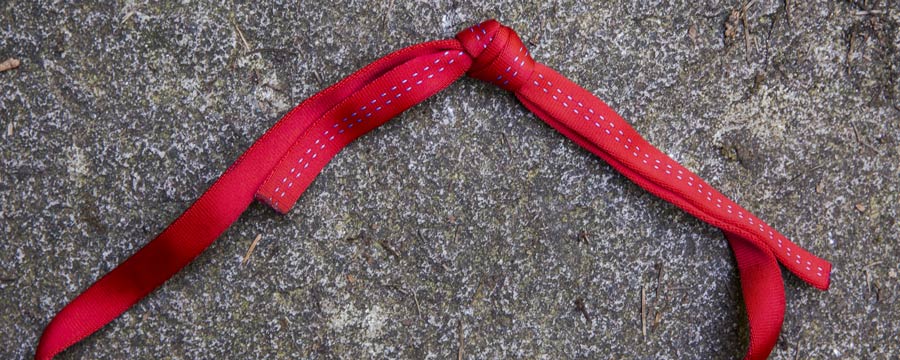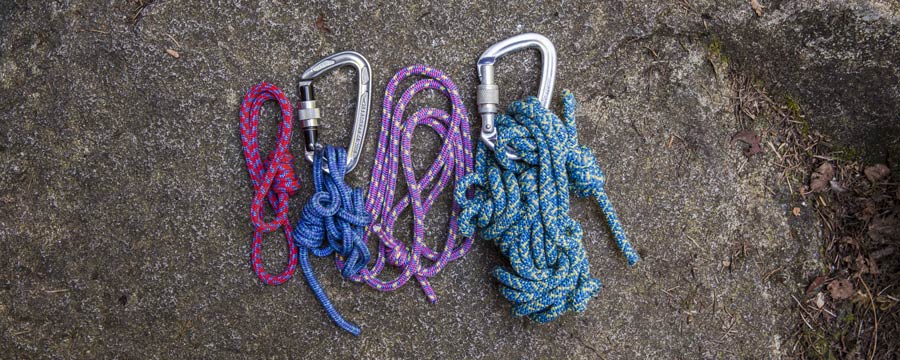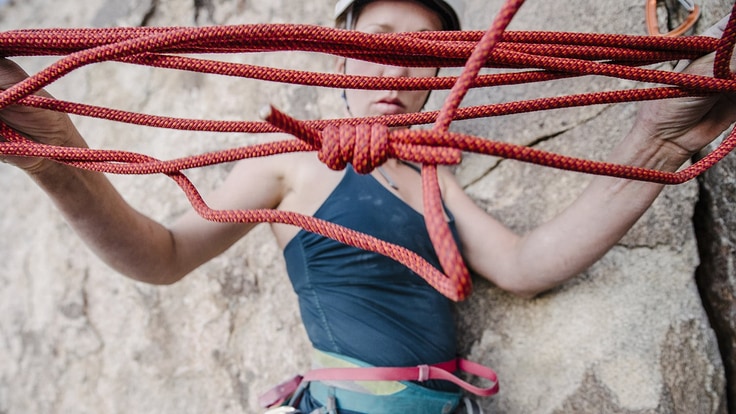When you're on the sharp end of the rope, a well-stocked rack is as important as a trustworthy belayer. If you're just getting into trad climbing, you'll need to know how to choose and use the following:
- Slings (also known as runners)
- Webbing
- Cord
These items are adaptable to a number of uses and act as multi-tools in your climbing arsenal.
If you're looking for information on quickdraws, see our in-depth articles on how to choose them and how to use them.
Climbing Slings

Though it can be made a number of ways, a sling (also known as a runner) is typically created by sewing a webbing section into a loop. A sling can be used as an extended quickdraw to allow your rope to run straighter and decrease friction on wandering routes, or it can be used to set up an anchor.
Sling Length
Slings come in a variety of lengths, widths and weights. Longer slings are more effective at reducing rope drag than a quickdraw, but are also heavier and bulkier.
- Single-length slings (60cm/24 in.) are a useful length—roughly 2 or 3 times longer than most quickdraws; they're a good length to wear over a shoulder or as an alpine quickdraw.
- Double-length slings (120cm/48 in.) give you greater extension for reducing rope drag or positioning pro; a perfect size for building two-bolt, fixed anchors, they can be worn doubled over a shoulder or as an alpine quickdraw.
- Extra-long slings (180-240cm/72-96 in.) are good for looping large rocks and for connecting three protection points to make an anchor.
- Shorter slings (30cm/12 in. and shorter) are a tweener size that wouldn't be used often; some climbers use them for tying off pitons.
- Quickdraw slings are presewn slings that let you make your own 'draws by adding the carabiners you choose.
Sling Materials
For years the main material in climbing slings has been nylon. Polyester has also been used, but it's not nearly as common as nylon. In recent years ultra-high-molecular-weight (UHMW) polyethylenes, with brand names like Dyneema, Dynex and Spectra have gained popularity. Some webbing is made by blending nylon with one of these super-strong branded materials.
The material of a sling affects the weight, strength, longevity, potential use and price of an item:
Advantages of nylon:
- More affordable
- Holds knots better and knots are stronger, due to its stretch and texture
- Stretch and higher melting temperature help it handle dynamic forces (falls)
Advantages of branded UHMW polyethylenes (Dyneema, Dynex and Spectra):
- Ultralight, due to an ultra-high strength-to-weight ratio
- More UV resistant
- Won't freeze when it gets wet
As long as you take extra care in knot tying and you avoid any scenario where a fall load isn't also supported by a dynamic rope, Spectra, Dyneema and Dynex can be used for most climbing applications.
Climbing Webbing

Most trad climbers take along additional sections of webbing to create custom-length slings for extending or building an anchor. Bulk webbing is sold by the foot, in spools or in sections.
Webbing Types
There are two types of webbing:
- Tubular webbing is the standard for climbing. Climbing webbing's tubular geometry makes it stronger and more durable than a similar width of flat webbing. It's also more pliable, so knots tied with it are both easier to create and stronger.
- Flat webbing is typically used for replacing backpack straps, building your own etriers or lashing down gear.
Webbing Widths
Available widths for bulk tubular webbing include 1" and 5/8". One inch is the standard width for making anchors, while 5/8" is often used to make homemade slings. (Flat webbing comes in a variety of widths, the most common ones being 2" and 1".)
Webbing Specifications
Bulk tubular webbing is available in "climbing specification" and "military specification." Climbing spec is thicker, heavier and slicker, whereas military spec is thinner, lighter and has a rougher surface texture. Both are very durable, but climbing-spec webbing is slightly stronger and more easily tied, and it holds knots more securely. (REI typically carries only climbing spec tubular webbing.)
Webbing Material
Bulk webbing is only available in nylon. If you make your own slings, tie your nylon webbing with a water knot that has long tails (at least 2" long).
Climbing Cord

Cord is useful for creating custom-length slings, such as a cordelette, that can be used in anchor construction or in friction hitches for rappels and aid climbing. Cord comes in diameters from 1mm up to 9mm, sometimes greater. It's sold by the foot or in sections: 20- or 30-foot sections are common lengths.
Cord Materials
Like slings, cord is available in two different materials Perlon (a type of nylon) and UHMW polyethylene (such as, Dyneema or Spectra).
The material affects the weight, strength, longevity, potential use and price of an item:
Advantages of Perlon:
- More affordable
- Holds knots better and knots are stronger, due to its stretch and texture
- Stretch and higher melting temperature help it handle dynamic forces (falls)
Advantages of branded UHMW polyethylenes (Dyneema and Spectra):
- Ultralight, due to an ultra-high strength-to-weight ratio
- More UV resistant
Common Cord Uses
Cordelette: Use 18 to 20 feet of 7mm or 8mm nylon cord or 5mm high-strength UHMW polyethylene (such as Spectra or Dyneema) tied in a loop. Use a double fisherman's knot for Perlon cord or a triple fisherman's knot for the thinner UHMW polyethylene cord.
This setup can work for everything from building a climbing anchor to making your own adjustable personal anchor system (PAS).
Self-belay loop: Use a 2- to 3-foot length of 5 - 8mm Perlon cord tied in a loop with a double fisherman's knot. This is a good length to make an autoblock hitch or prusik hitch to use as a backup brake while rappelling. These loops also come in handy in aid climbing and crevasse rescue. The length of the loop depends on the exact use and it may take some experimentation to get it just right.
Gear Quantities
How many of each piece of gear you carry and the organization of your rack will vary immensely. A basic trad rack might include 12 single-length slings, 4 to 6 double-length slings and 2 triples (or 2 cordelettes) for the anchors.
Factors like the type of climbing, the length and type of route, the rock and character of the climbing area and your personal climbing style all play a role in how you set up your rack. For more details, see Gear Racking Basics.
Sling, Webbing and Cord Lifespan
Slings, webbing and cords don't last forever. Most sling makers state that, even if never used, a sling should be retired after 10 years.
With moderate use and no major incidents, the lifespan of a sewn sling is two to five years. The actual lifespan depends on how frequently you use it and on whether or not it incurs damage. Inspect slings and replace them if you find any of the following conditions
- A rip or hole in the webbing
- Burnt, singed or melted areas
- Fraying of the webbing itself or the stitching
- Significant fading due to exposure to sunlight
- Discoloration from contact with damaging fluids
In addition, any sling involved in a severe fall should be replaced. If you have any doubts about the dependability of your gear, retire it.
Additional Types of Sewn Slings
Gear slings are padded pieces of nylon webbing that you wear over your shoulder or like a pack to carry all your protection, slings and quickdraws while trad climbing.
Etriers: Also called "aiders," etriers are essential for aid climbing. They are basically 1" flat nylon webbing ladders with 4 to 8 steps for moving upwards once you have clipped a piece of gear.
Daisy chains are sewn slings with multiple loops created by bar-tack stitching. They are an essential component of an aid-climbing setup and work hand in hand with etriers. Daisy chains connect the etrier to the harness so you can't drop the etrier.
Always remember: Your safety is your responsibility. No article or video can replace proper instruction and experience. Make sure you're practiced in proper techniques and safety requirements before you climb.

